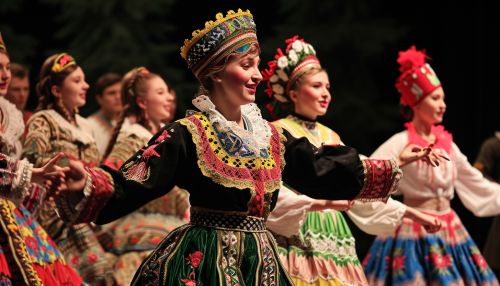Slavic folk dance
Origins and History
The Slavic folk dance is a traditional form of dance that has its roots in the customs and traditions of the Slavic peoples. These dances have been passed down from generation to generation, preserving the cultural heritage of the Slavic nations. The origins of Slavic folk dance can be traced back to pagan rituals and ceremonies that were performed by the ancient Slavic tribes. These dances were often performed during important events such as weddings, harvests, and religious festivals.


Characteristics
Slavic folk dances are characterized by their rhythmic complexity and intricate footwork. The dancers often form circles or lines and perform synchronized movements. The dances can be either fast-paced and energetic or slow and graceful, depending on the music and the occasion. The dancers usually wear traditional Slavic costumes, which add to the visual appeal of the performance.
Types of Slavic Folk Dances
There are many different types of Slavic folk dances, each with its own unique characteristics and traditions. Some of the most popular ones include:
Polka
The Polka is a lively dance that originated in the mid-19th century in Bohemia, a region in the modern-day Czech Republic. It is characterized by its quick tempo and a pattern of hop-step-close-step.
Kolo
The Kolo is a traditional circle dance from the Balkan region. The dancers hold each other's hands or belts and move in a circle, performing a series of steps and hops.
Troika
The Troika is a Russian folk dance that simulates a horse-drawn sleigh ride. It is performed by three dancers, hence the name 'Troika', which means 'three' in Russian.
Csárdás
The Csárdás is a traditional Hungarian folk dance, but it is also popular among the Slavic peoples of the Carpathian Basin. It is characterized by a variation in tempo: it starts slow (lassú) and ends fast (friss).
Role in Society
Slavic folk dances play an important role in the social and cultural life of the Slavic peoples. They are not just a form of entertainment, but also a way to express national identity and preserve cultural heritage. These dances are often performed at social gatherings, festivals, and special occasions such as weddings and anniversaries. They are also taught in schools and dance studios, ensuring that the tradition is passed on to the next generation.
Modern Interpretations and Influence
In the modern era, Slavic folk dances have gained international recognition and have influenced many forms of dance around the world. They have been incorporated into the repertoire of many dance companies and have been performed on international stages. In addition, elements of Slavic folk dance have been incorporated into modern dance styles, such as contemporary dance and ballroom dance.
